Experimental Study of Wind Pressures on Low-Rise H-Shaped Buildings
Abstract
1. Introduction
2. Materials and Methods
2.1. Building Models
2.2. Experimental Setup
2.3. Measurements
2.4. Data Processing
- I.
- The dynamic pressure measured on the model surfaces was converted to Cp as follows:
- II.
- Then, considering that only the first quadrant (Qa) of the model was equipped, the next step was to mirror the data to the rest of the model (quadrant divisions can be found in Figure 2a). The formula used to obtain the respective angle for each quadrant can be found in the appendix (Equations (A1)–(A3)).
- III.
- Cp values were time-averaged and exported in the appropriate format to generate the surface Cp contours in SURFER 7®.
- IV.
- The mentioned contour images were manually generated in Surfer 7® [44].
- V.
- Next, the numeric data were organized and plotted in graphics, as presented in Section 3.
3. Results and Discussion
3.1. Horizontal Pressure Distribution
3.2. Vertical Pressure Evolution
3.3. Cp Contours
4. Conclusions
Supplementary Materials
Author Contributions
Funding
Data Availability Statement
Acknowledgments
Conflicts of Interest
Appendix A
| Element Type | Number of Rows | Number of Elements | Dimensions [m] | Spacing (from the Object Axis) | |
|---|---|---|---|---|---|
| Between Element [m] | Between Rows [m] | ||||
| Triangular spire | 1 | 3 | 0.60 × 0.86, H = 2.2 | 1.00 | 0.60 |
| Cube 1 | 11 | 61 | 0.14 × 0.14, H = 0.14 | 0.50 | 0.40 |
| Cube 2 | 1 | 7 | 0.08 × 0.08, H = 0.10 | 0.50 | 0.32 |
| Cube 3 | 1 | 6 | 0.08 × 0.08 m, H = 0.06 m | 0.50 | 0.30 |
| Cube 4 | 3 | 20 | 0.08 × 0.08 m, H = 0.03 m | 0.50 | 0.10 |

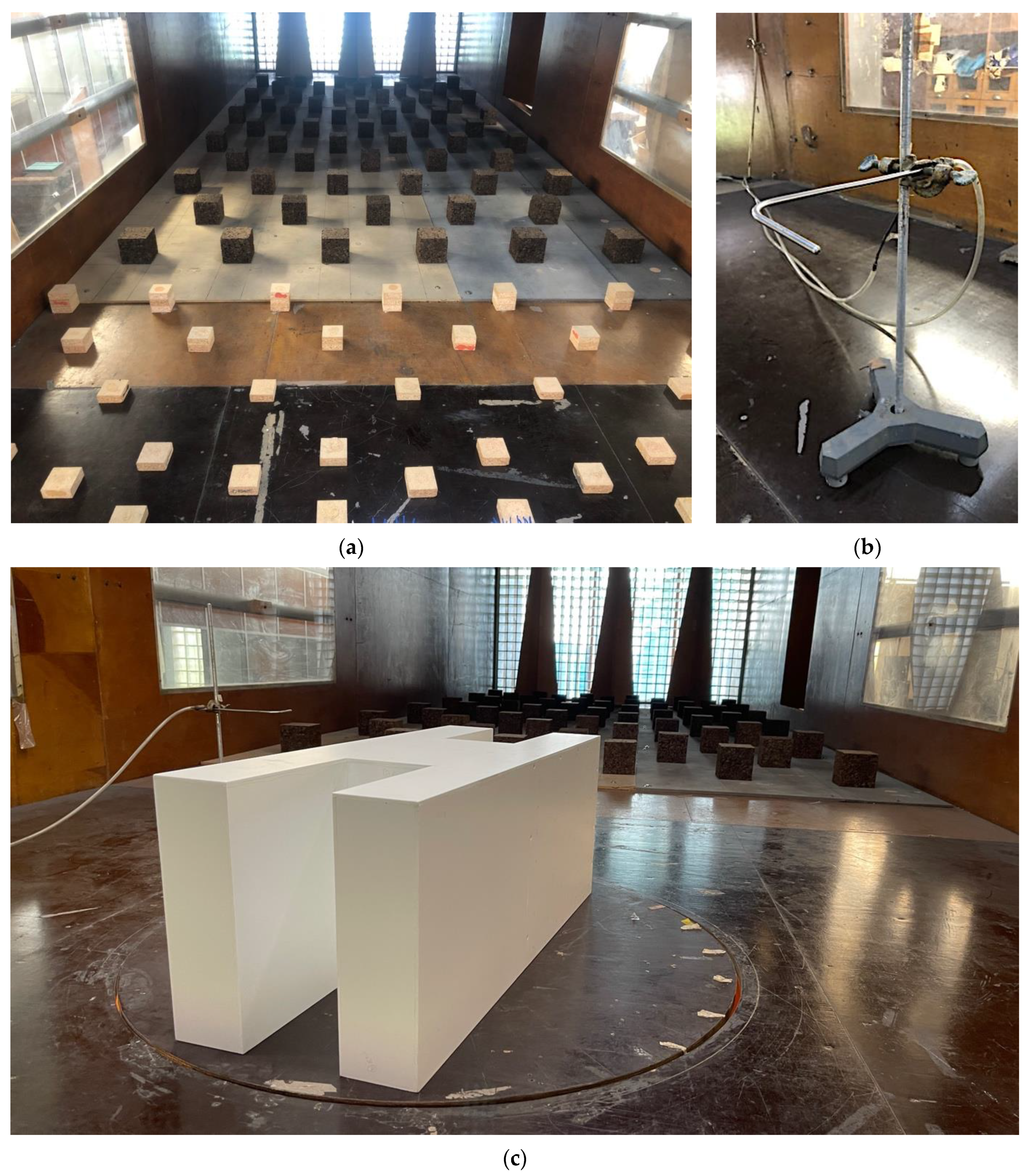
References
- IPCC Summary for Policymakers. In Climate Change 2022: Mitigation of Climate Change: Working Group III to the Sixth Assessment Report of the Intergovernmental Panel on Climate Change; Al Khourdajie, A., Hasija, A., McCollum, D., Lisboa, G., Malley, J., Belkacemi, M., Pathak, M., Vyas, P., Slade, R., Diemen, R., et al., Eds.; Cambridge University Press: Cambridge, UK; New York, NY, USA, 2022; p. 52. ISBN 9781107415416. [Google Scholar]
- Rivero, R. Arquitetura e Clima; Luzzatto, D.C., Ed.; Editora da Universidade: Porto Alegre, Brazil, 1986; ISBN 9788585038441. [Google Scholar]
- Givoni, B. Comfort, Climate Analysis and Building Design Guidelines. Energy Build. 1992, 18, 11–23. [Google Scholar] [CrossRef]
- Rudnick, S.N.; Milton, D.K. Risk of Indoor Airborne Infection Transmission Estimated from Carbon Dioxide Concentration. Indoor Air 2003, 13, 237–245. [Google Scholar] [CrossRef] [PubMed]
- Zemouri, C.; Awad, S.F.; Volgenant, C.M.C.; Crielaard, W.; Laheij, A.M.G.A.; de Soet, J.J. Modeling of the Transmission of Coronaviruses, Measles Virus, Influenza Virus, Mycobacterium Tuberculosis, and Legionella Pneumophila in Dental Clinics. J. Dent. Res. 2020, 99, 22034520940288. [Google Scholar] [CrossRef] [PubMed]
- Wong, S.Y.Y.; Lam, K.M.M. Effect of Recessed Cavities on Wind-Induced Loading and Dynamic Responses of a Tall Building. J. Wind. Eng. Ind. Aerodyn. 2013, 114, 72–82. [Google Scholar] [CrossRef]
- Teixeira, C.A.; Invidiata, A.; Sorgato, M.J.; Melo, A.P.; Fossati, M.; Lamberts, R. Levantamento Das Características de Edifícios Residenciais Brasileiros; Centro Brasileiro de Eficiência Energética em Edificações (CB3e): Florianopolis, Brazil, 2015. [Google Scholar]
- Winiarski, D.W.; Halverson, M.A.; Jiang, W. Analysis of Building Envelope Construction in 2003 CBECS; United States Departemant of Energy: Richland, WA, USA, 2007. [Google Scholar]
- Montes, M.A.T. Abordagem Integrada No Ciclo de Vida de Habitação de Interesse Social Considerando Mudanças Climáticas; Universidade Federal de Santa Catarina: Florianópolis, Brazil, 2016. [Google Scholar]
- Secretaria Nacional da Habitação Sistema de Gerenciamento Da Habitação: Dados Abertos Da SNH. Available online: http://sishab.mdr.gov.br/dados_abertos/sistema_habitacao (accessed on 19 December 2022).
- Sanketh, P.; Rao, B.D.V.C.M. Effect of Symmetrical Floor Plan Shapes with Re-Entrant Corners on Seismic Behavior of RC Buildings. i-Manag. J. Struct. Eng. 2015, 4, 15–21. [Google Scholar] [CrossRef]
- Morais, J.M.S.C.; Labaki, L.C. Evaluating Natural Ventilation in Multi-Storey Social Housing. In Proceedings of the PLEA 2013—29th Conference, Sustainable Architecture for a Renewable Future, Munich, Germany, 10–12 September 2013. [Google Scholar]
- Cheng, C.K.C.; Lam, K.M.; Leung, Y.T.A.; Yang, K.; Li Danny, H.W.; Cheung Sherman, C.P. Wind-Induced Natural Ventilation of Re-Entrant Bays in a High-Rise Building. J. Wind Eng. Ind. Aerodyn. 2011, 99, 79–90. [Google Scholar] [CrossRef]
- Hong Kong Government Outbreak at the Amoy Garden. Report of the Select Committee to Inquire into the Handling of the Severe Acute Respiratory Syndrome Outbreak by the Government and the Hospital Authority; Legislative Counsil of Hong Kong: Hong Kong, China, 2004. [Google Scholar]
- Asfour, O.S.; Gadi, M.B. A Comparison between CFD and Network Models for Predicting Wind-Driven Ventilation in Buildings. Build. Environ. 2007, 42, 4079–4085. [Google Scholar] [CrossRef]
- Bre, F.; Gimenez, J.M. A Cloud-Based Platform to Predict Wind Pressure Coefficients on Buildings. Build. Simul. 2022, 15, 1507–1525. [Google Scholar] [CrossRef] [PubMed]
- Cóstola, D.; Blocken, B.; Hensen, J.J.L.M.L.M.J.; Costola, D.; Blocken, B.; Hensen, J.J.L.M.L.M.J.; Cóstola, D.; Blocken, B.; Hensen, J.J.L.M.L.M.J. Overview of Pressure Coefficient Data in Building Energy Simulation and Airflow Network Programs. Build. Environ. 2009, 44, 2027–2036. [Google Scholar] [CrossRef]
- Yuan, K.; Hui, Y.; Chen, Z. Effects of Facade Appurtenances on the Local Pressure of High-Rise Building. J. Wind Eng. Ind. Aerodyn. 2018, 178, 26–37. [Google Scholar] [CrossRef]
- Hui, Y.; Yuan, K.; Chen, Z.; Yang, Q. Characteristics of Aerodynamic Forces on High-Rise Buildings with Various Façade Appurtenances. J. Wind Eng. Ind. Aerodyn. 2019, 191, 76–90. [Google Scholar] [CrossRef]
- Li, B.; Liu, J.; Gao, J. Surface Wind Pressure Tests on Buildings with Various Non-Uniformity Morphological Parameters. J. Wind Eng. Ind. Aerodyn. 2015, 137, 14–24. [Google Scholar] [CrossRef]
- Tominaga, Y.; Shirzadi, M. Wind Tunnel Measurement of Three-Dimensional Turbulent Flow Structures around a Building Group: Impact of High-Rise Buildings on Pedestrian Wind Environment. Build. Environ. 2021, 206, 108389. [Google Scholar] [CrossRef]
- Gimenez, J.M.; Bre, F. An Enhanced K-ω SST Model to Predict Airflows around Isolated and Urban Buildings. Build. Environ. 2023, 237, 110321. [Google Scholar] [CrossRef]
- Shelley, E.; Hubbard, E.; Zhang, W. Comparison and Uncertainty Quantification of Roof Pressure Measurements Using the NIST and TPU Aerodynamic Databases. J. Wind Eng. Ind. Aerodyn. 2023, 232, 105246. [Google Scholar] [CrossRef]
- Li, Y.-G.Y.Y.; Liu, P.; Li, Y.-G.Y.Y.; Yan, J.-H.J.; Quan, J. Wind Loads Characteristics of Irregular Shaped High-Rise Buildings. Adv. Struct. Eng. 2022, 26, 3–16. [Google Scholar] [CrossRef]
- Zhong, H.-Y.; Jing, Y.; Liu, Y.; Zhao, F.-Y.; Liu, D.; Li, Y. CFD Simulation of “Pumping” Flow Mechanism of an Urban Building Affected by an Upstream Building in High Reynolds Flows. Energy Build. 2019, 202, 109330. [Google Scholar] [CrossRef]
- Albuquerque, D.P.P. de Simplified Modelling of Wind-Driven Sigle-Sided Ventilation. Ph.D. Thesis, Faculdade de Ciências da Universidade de Lisboa, Lisboa, Portugal, 2021. [Google Scholar]
- Albuquerque, D.P.; Sandberg, M.; Linden, P.F.; Carrilho da Graça, G. Experimental and Numerical Investigation of Pumping Ventilation on the Leeward Side of a Cubic Building. Build. Environ. 2020, 179, 106897. [Google Scholar] [CrossRef]
- Cheng, L.; Lam, K.M.; Wong, S.Y. POD Analysis of Crosswind Forces on a Tall Building with Square and H-Shaped Cross Sections. Wind Struct. 2015, 21, 63–84. [Google Scholar] [CrossRef]
- Klein, P.; Rau, M.; Roeckle, R.; Plate, E.J. Concentration Estimation around Point Sources Located in the Vicinity of U-Shape Buildings. In Air Pollution II: Pollution Control and Monitoring; WIT Press, IT Transactions on Ecology and the Environmen: Barcelona, Spain, 1994; Volume 2, pp. 473–480. [Google Scholar]
- Götting, J.; Winkler, C.; Rau, M.; Moussiopoulos, N.; Ernst, G. Dispersion of a Passive Pollutant in the Vicinity of a U-Shaped Building. Int. J. Environ. Pollut. 1997, 8, 718–726. [Google Scholar] [CrossRef]
- Wang, D.; Yu, X.J.; Zhou, Y.; Tse, K.T. A Combination Method to Generate Fluctuating Boundary Conditions for Large Eddy Simulation. Wind Struct. 2015, 20, 579–607. [Google Scholar] [CrossRef]
- Mandal, S.; Dalui, S.K.; Bhattacharjya, S. Influence of Side Ratio on Wind Induced Responses of U Plan Shape Tall Building. In Recent Trends in Civil Engineering; Lecture Notes in Civil Engineering; Springer: Singapore, 2023; Volume 274, pp. 345–355. ISBN 9789811940545. [Google Scholar]
- Gunaydin, T.I. Numerical Study of Wind Induced Pressures on Irregular Plan Shapes. ICONARP Int. J. Archit. Plan. 2021, 9, 646–679. [Google Scholar] [CrossRef]
- Nagar, S.K.; Raj, R.; Dev, N. Experimental Study of Wind-Induced Pressures on Tall Buildings of Different Shapes. Wind Struct. 2020, 31, 441–453. [Google Scholar] [CrossRef]
- Ali, M.M.; Al-Kodmany, K. Tall Buildings and Urban Habitat of the 21st Century: A Global Perspective. Buildings 2012, 2, 384–423. [Google Scholar] [CrossRef]
- Kishor, C.M.; Coulbourne, W.L. Wind Loads: Guide to the Wind Load Provisions of ASCE 7-10; American Society of Civil Engineers (ASCE): Reston, VA, USA, 2013; ISBN 978-0-7844-7778-6. [Google Scholar]
- Wieringa, J. Updating the Davenport Roughness Classification. J. Wind Eng. Ind. Aerodyn. 1992, 41, 357–368. [Google Scholar] [CrossRef]
- Lopes, M.F.P.; Gomes, M.G.; Ferreira, J.G. Simulation of the Atmospheric Boundary Layer for Model Testing in a Short Wind Tunnel. Exp. Tech. 2008, 32, 36–43. [Google Scholar] [CrossRef]
- Tokyo Polytechnic University. Aerodynamic Database for Low-Rise Buildings with Varied Eaves; Tokyo Polytechnic University: Tokyo, Japan, 2007. [Google Scholar]
- Andrioli Medinilha-Carvalho, T.; Marques da Silva, F.V.; Bre, F.; Gimenez, J.M.; Labaki, L.C. Experimental Wind Pressure Database of Low-Rise and H-Shaped Buildings (1.0) [Data Set]. 2023. Zenodo. Available online: https://zenodo.org/records/8257276 (accessed on 23 February 2024).
- DTC Initium Utility Software, Version 2.00a; TE Connectivity: Los Angeles, CA, USA, 2017.
- Sousa, J.H.; Gomes, M.G.; da Silva, F.M.; Tomé, A. Systematization of Spatial Functional Layouts and Pedestrian Wind Comfort Assessment for an Ultra-Thin Triangular Free Form Shell Structure. Build. Environ. 2023, 246, 110951. [Google Scholar] [CrossRef]
- De Paepe, W.; Pindado, S.; Bram, S.; Contino, F. Simplified Elements for Wind-Tunnel Measurements with Type-III-Terrain Atmospheric Boundary Layer. Meas. J. Int. Meas. Confed. 2016, 91, 590–600. [Google Scholar] [CrossRef]
- Morse, S.M. Wind Pressure Fields around Non-Rectangular Buildings. Master’s Thesis, Texas Tech University, Lubbock, TX, USA, 2003. [Google Scholar]
- Surfer, version 7; Golden Software: Golden, CO, USA, 1999.
- Spyder, version 5.1.5; Python Software Foundation: Wilmington, DE, USA, 2020.
- Andrioli Medinilha-Carvalho, T.; Marques da Silva, F.V.; Bre, F.; Gimenez, J.M.; Labaki, L.C. Automated Data Processing Script for Wind Tunnel Measurements in Python (1.0). Zenodo. 2023. Available online: https://zenodo.org/records/8247854 (accessed on 23 February 2024).
- Inan Gunaydin, T. Wind Flow on and around U-Shaped Buildings. J. Eng. Des. Technol. 2022, 20, 841–859. [Google Scholar] [CrossRef]

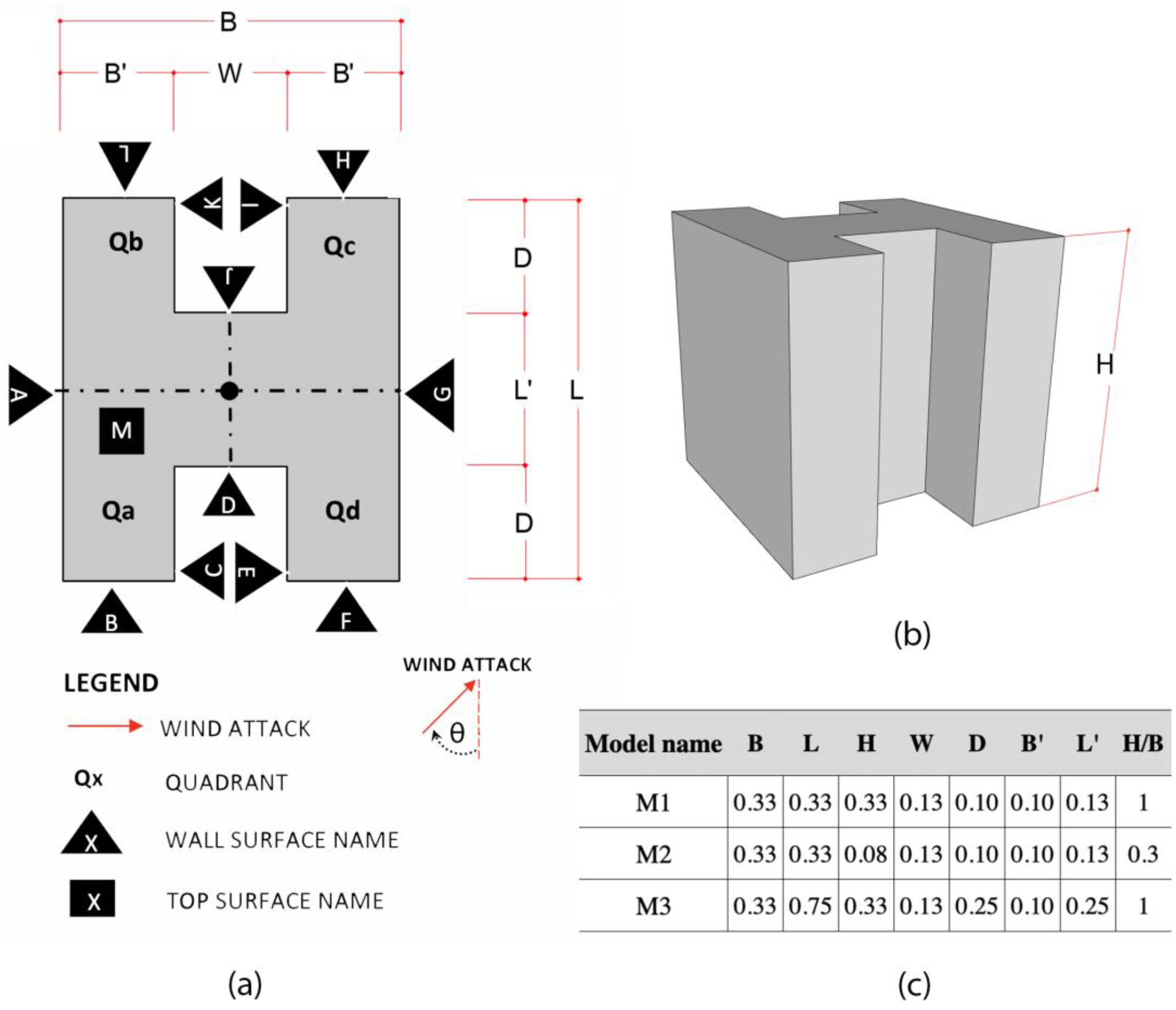
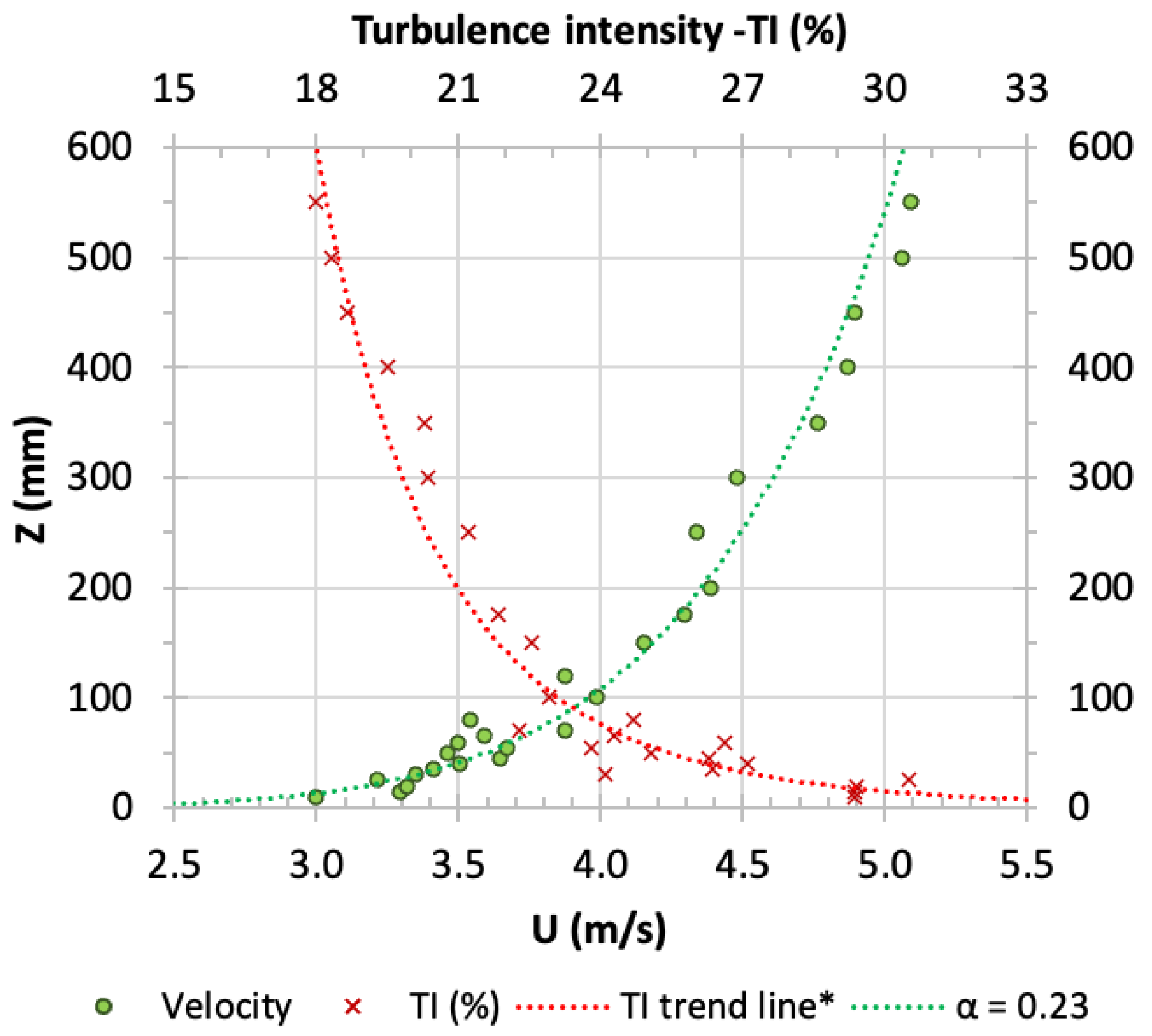

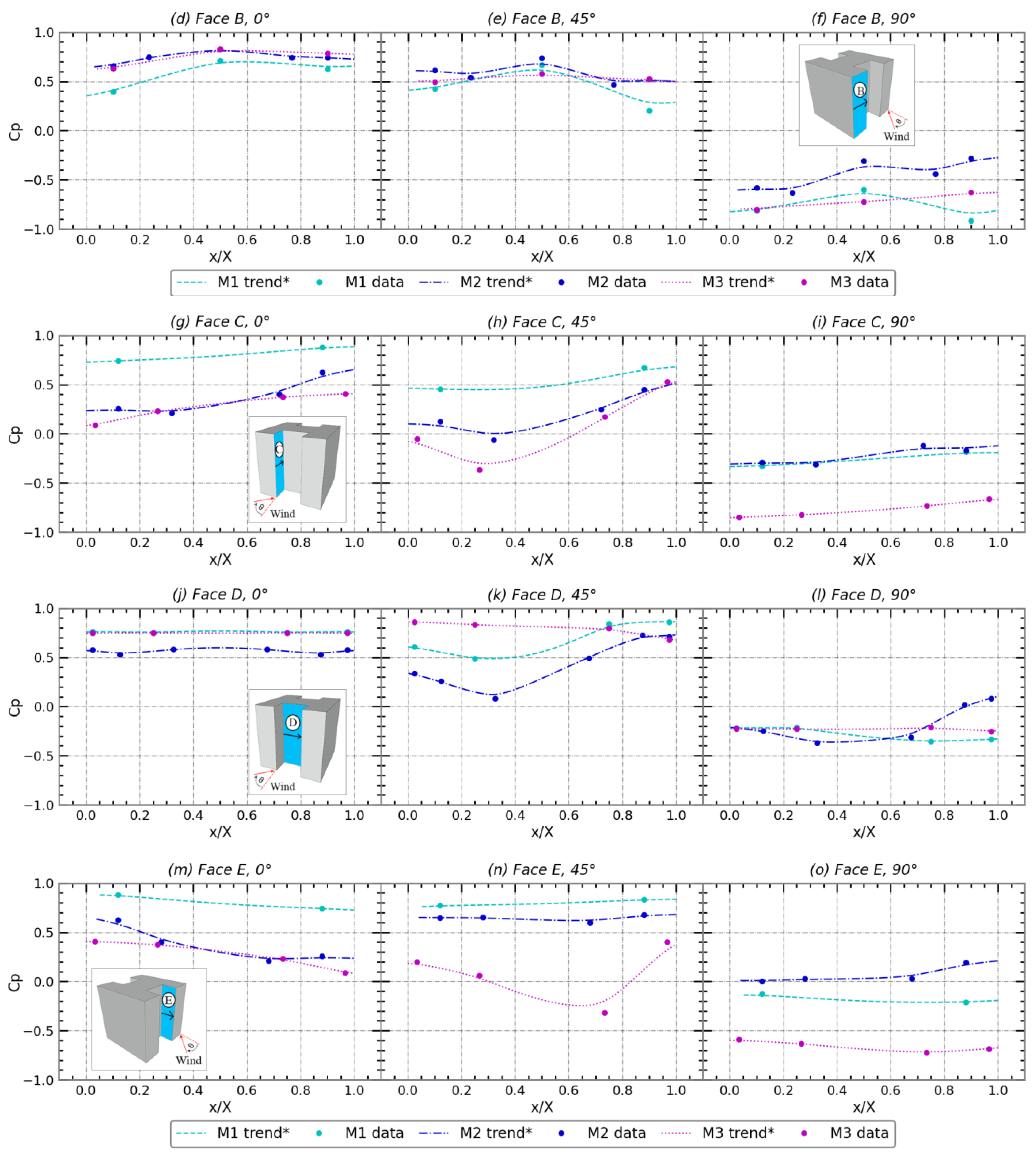
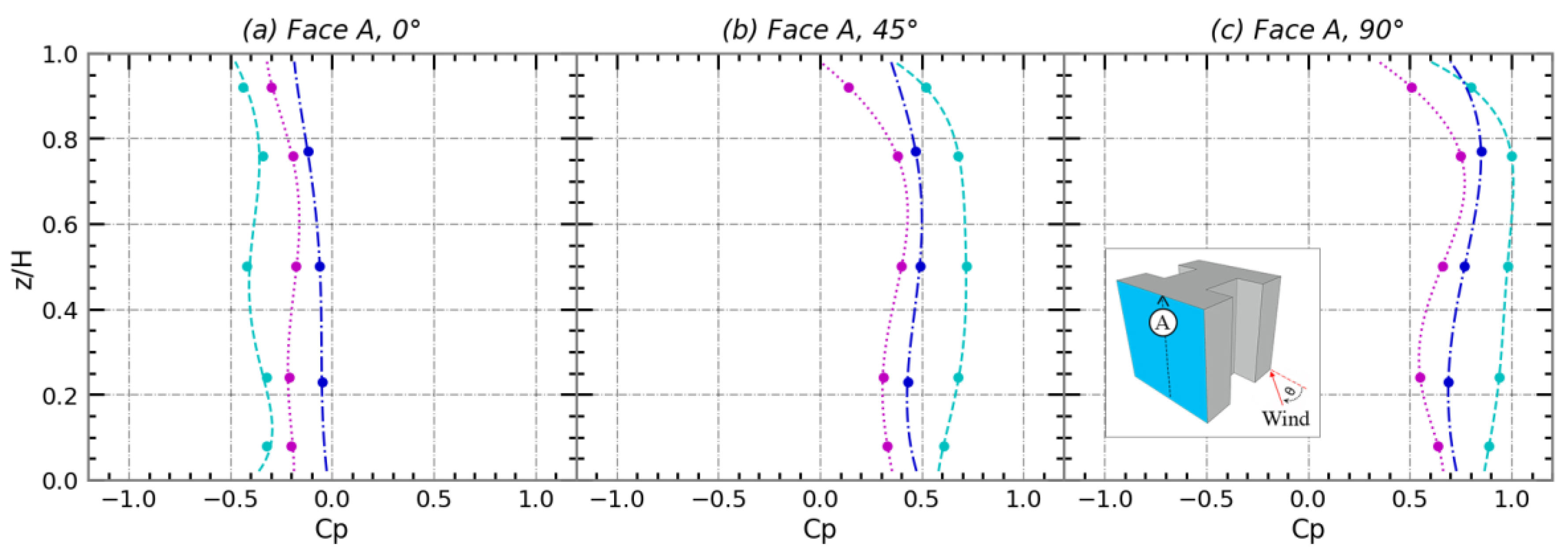
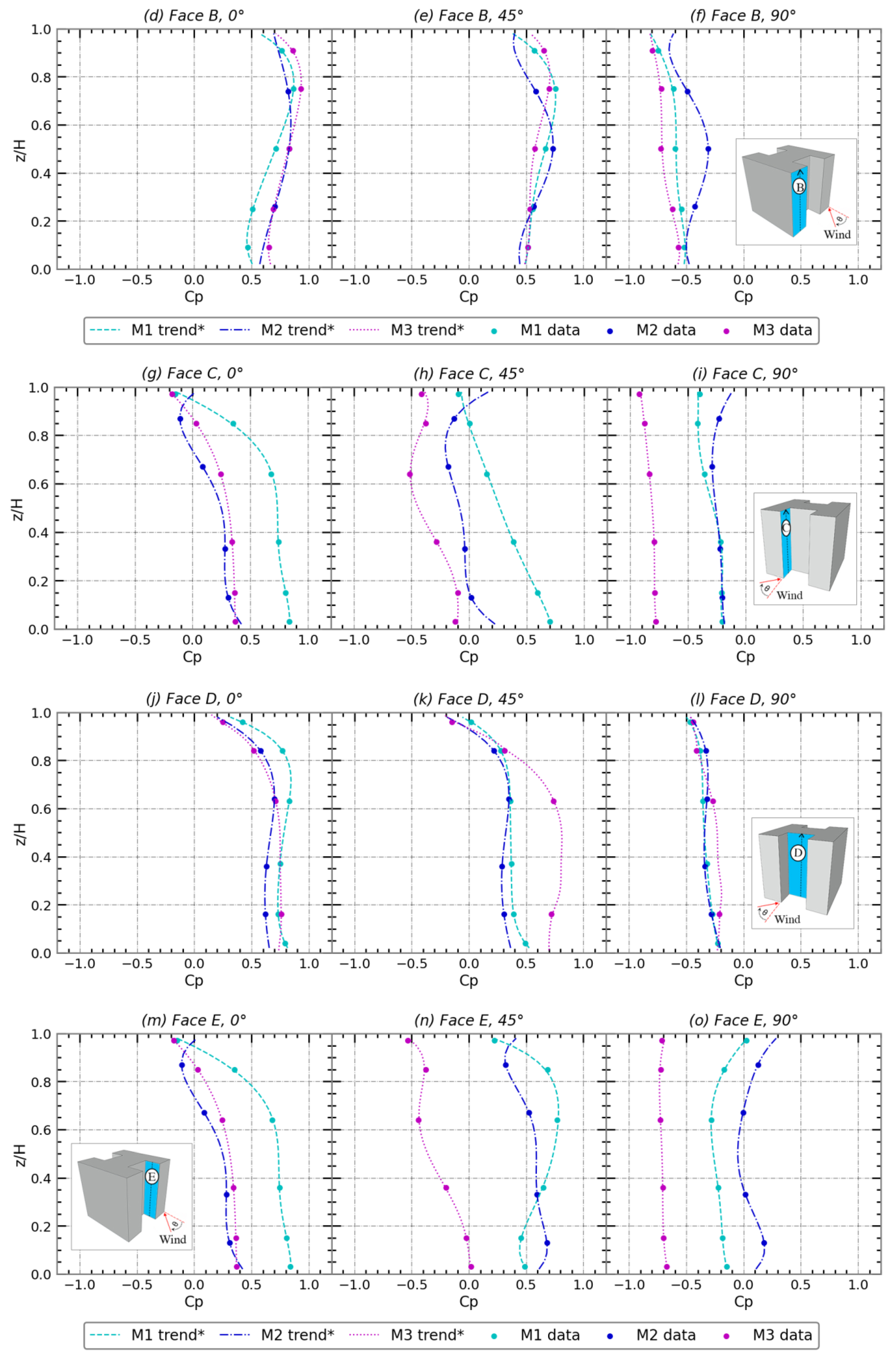
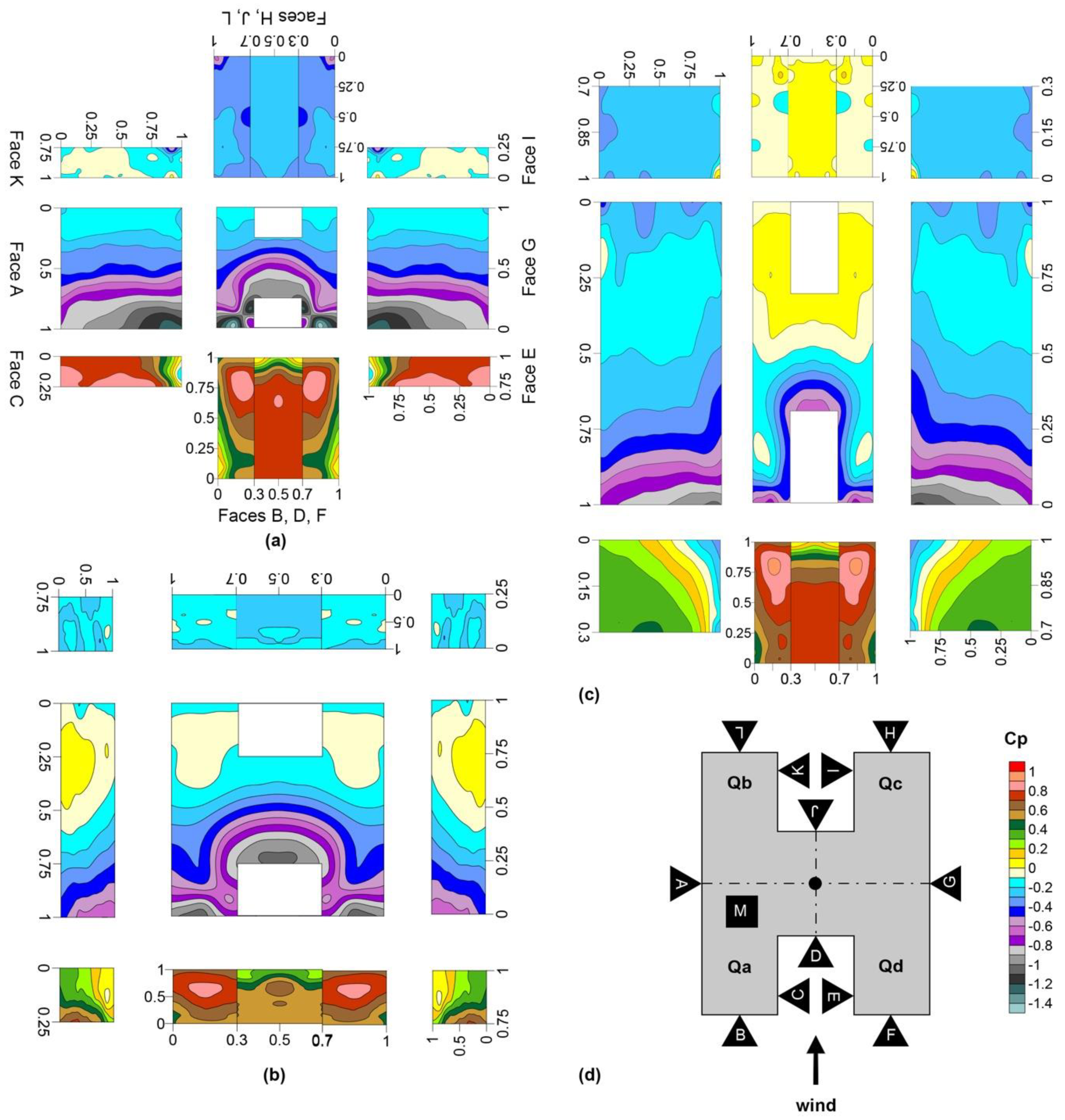
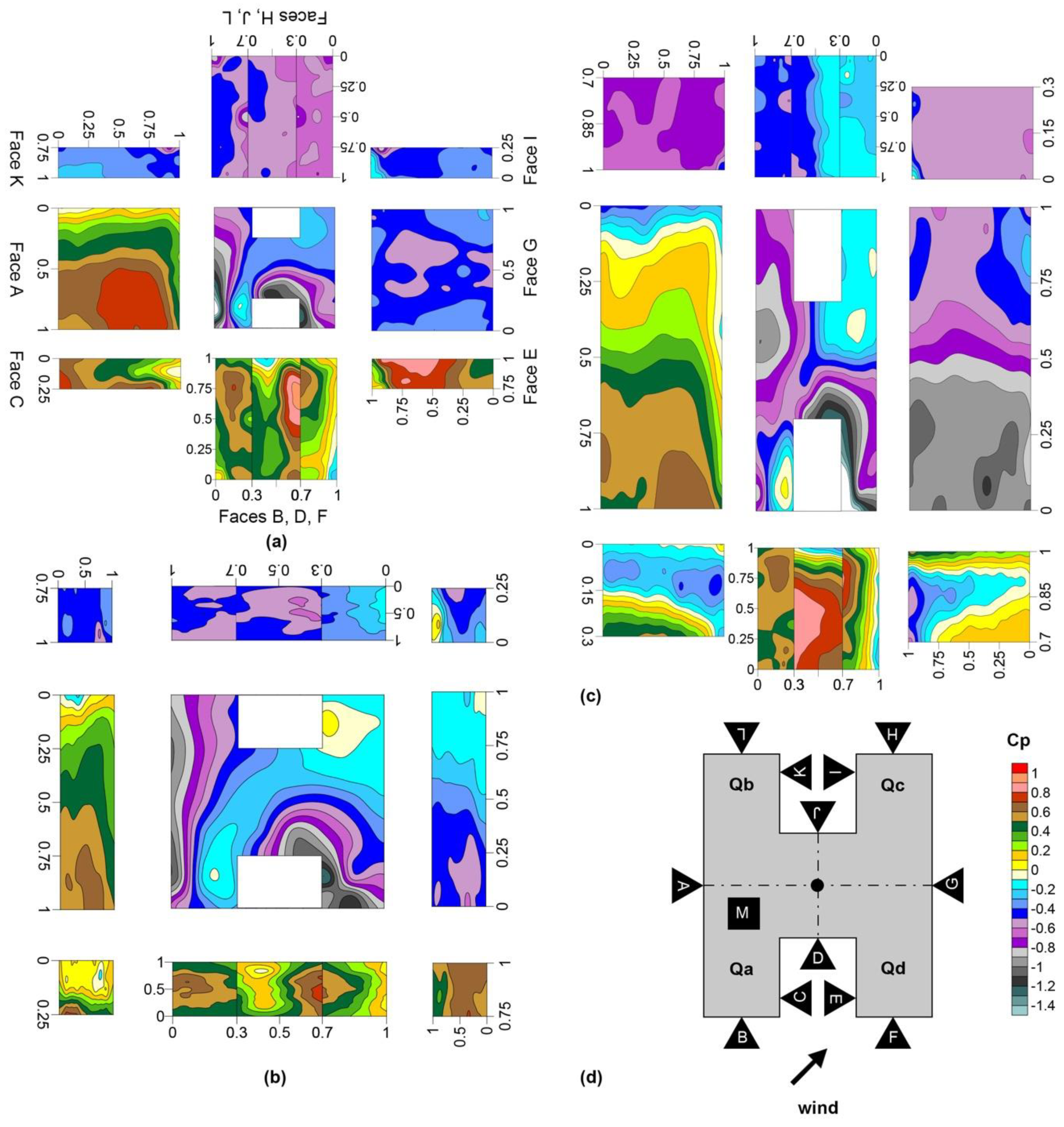
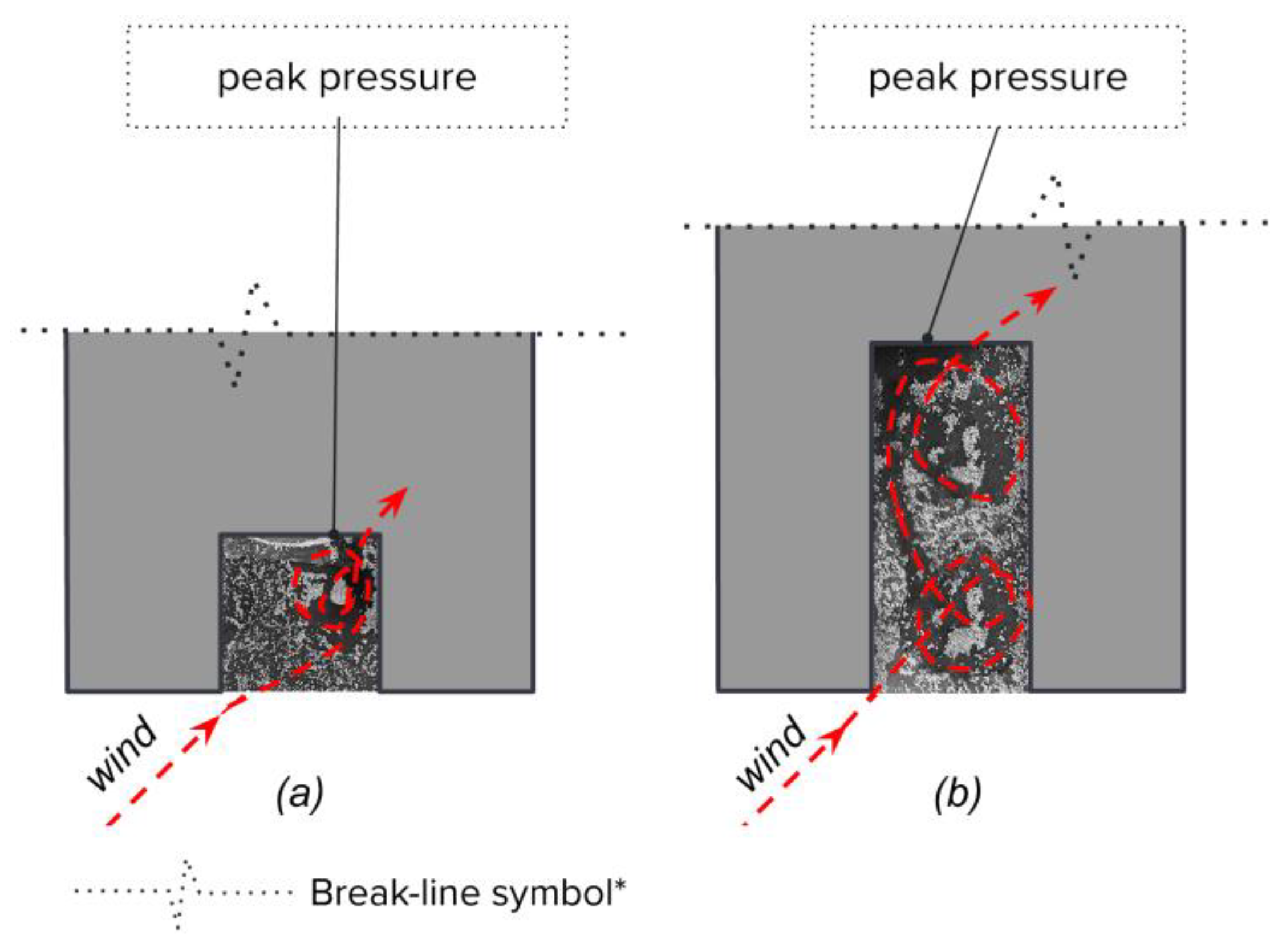
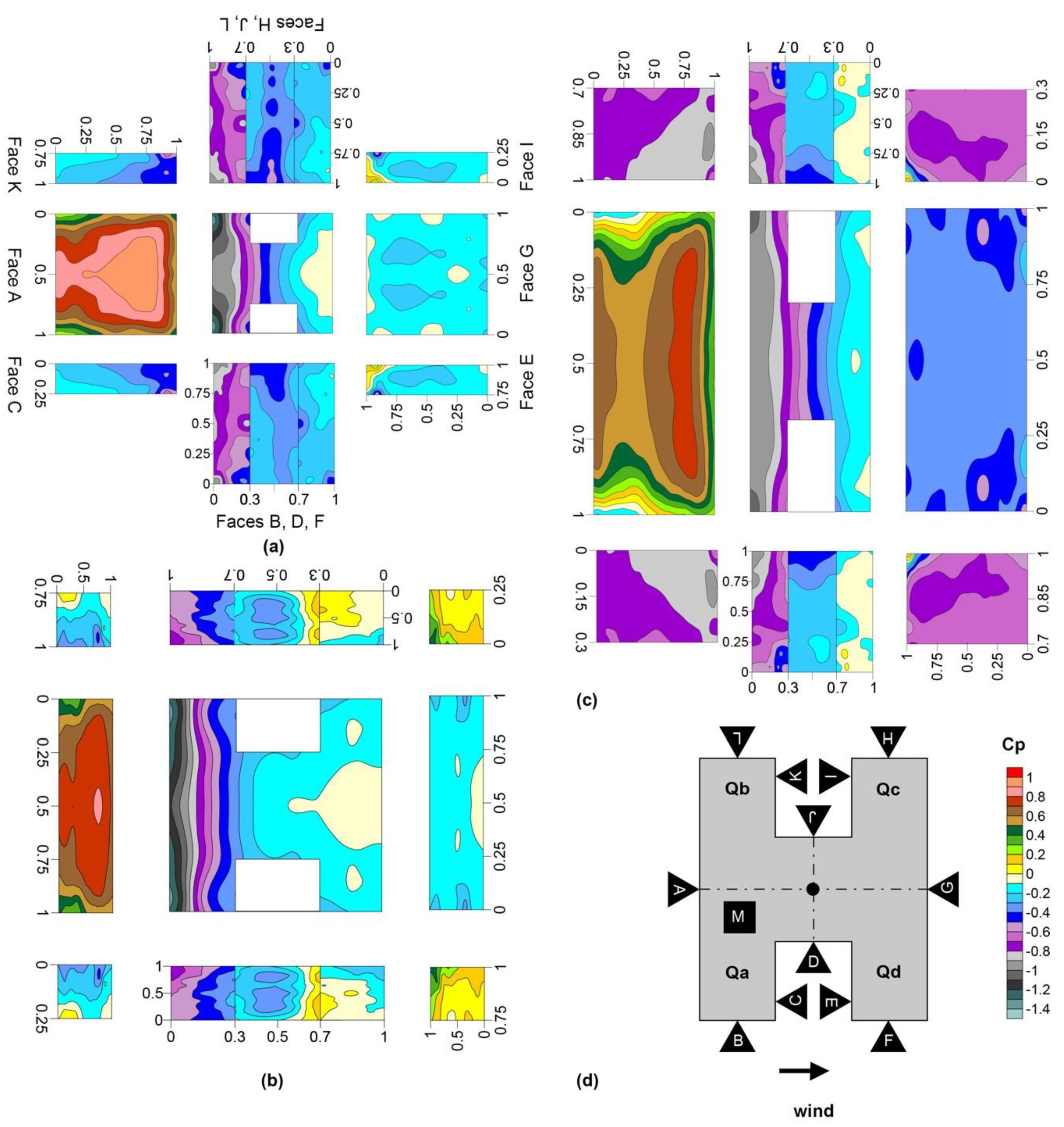
Disclaimer/Publisher’s Note: The statements, opinions and data contained in all publications are solely those of the individual author(s) and contributor(s) and not of MDPI and/or the editor(s). MDPI and/or the editor(s) disclaim responsibility for any injury to people or property resulting from any ideas, methods, instructions or products referred to in the content. |
© 2024 by the authors. Licensee MDPI, Basel, Switzerland. This article is an open access article distributed under the terms and conditions of the Creative Commons Attribution (CC BY) license (https://creativecommons.org/licenses/by/4.0/).
Share and Cite
Andrioli Medinilha-Carvalho, T.; Marques da Silva, F.V.; Bre, F.; Gimenez, J.M.; Chebel Labaki, L. Experimental Study of Wind Pressures on Low-Rise H-Shaped Buildings. Buildings 2024, 14, 762. https://doi.org/10.3390/buildings14030762
Andrioli Medinilha-Carvalho T, Marques da Silva FV, Bre F, Gimenez JM, Chebel Labaki L. Experimental Study of Wind Pressures on Low-Rise H-Shaped Buildings. Buildings. 2024; 14(3):762. https://doi.org/10.3390/buildings14030762
Chicago/Turabian StyleAndrioli Medinilha-Carvalho, Talita, Fernando Vítor Marques da Silva, Facundo Bre, Juan M. Gimenez, and Lucila Chebel Labaki. 2024. "Experimental Study of Wind Pressures on Low-Rise H-Shaped Buildings" Buildings 14, no. 3: 762. https://doi.org/10.3390/buildings14030762
APA StyleAndrioli Medinilha-Carvalho, T., Marques da Silva, F. V., Bre, F., Gimenez, J. M., & Chebel Labaki, L. (2024). Experimental Study of Wind Pressures on Low-Rise H-Shaped Buildings. Buildings, 14(3), 762. https://doi.org/10.3390/buildings14030762







